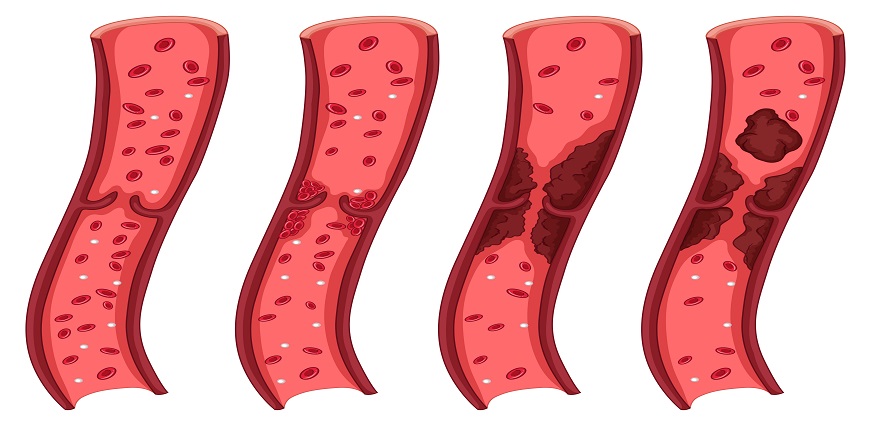





No lab centers are available in this city

Buerger's disease, or thromboangiitis obliterans, is a rare condition most often found in smokers. The inflamed blood vessels in their arms, legs, feet, and hands make it hard for blood to travel through the vessels. When clots form, the symptoms get worse and cause pain and tissue damage. Quitting smoking is the best way to start feeling better.
Buerger's disease is a rare condition that affects the blood vessels in your arms, legs, fingers and toes. It can cause inflammation inside the blood vessels, making it difficult to move your blood through them. As a result of these difficulties, you may experience pain and damaged tissues beginning in your fingers and toes, spreading to your legs and arms.
Buerger's disease can be a symptom of Raynaud's disease, commonly known as Raynaud's phenomenon. When you have Raynaud's disease, tension or a feeling of cold causes the blood vessels in your fingers and toes to burst. Your skin appears white or blue when not enough blood is passing through your blood vessels. Your skin may seem red and feel tingly or numb after a few minutes or hours.
Wearing gloves, warm socks, or simply warming up your hands will help alleviate the sensations. Raynaud's illness has less symptoms than Buerger's disease, which is painful and has many more.
When you're at rest, your arms and legs may experience severe pain. You can develop sores on your fingers or toes, and your hands or feet might feel hot, numb, or tingly. You may develop skin ulcers or muscle spasms over time.
Although the exact cause of Buerger's disease is unknown, scientists believe that something in cigarettes damages the blood vessel lining. The majority of those who have Buerger's illness smoke cigarettes. Your genes could increase your risk of developing Buerger's disease. Some researchers believe it to be an autoimmune disorder
Buerger's disease has an elusive specific origin, however smoking is closely associated with its onset. According to research, cigarettes may include compounds that irritate blood vessel linings and cause swelling.
Almost everyone who has been given a diagnosis of Buerger's disease smokes cigarettes or uses chewing tobacco or other tobacco products.
Don't use any tobacco products or smoke cigarettes if you wish to avoid developing Buerger's illness.
Over time, Buerger's disease symptoms appear gradually. These signs include:
After you've had Buerger's disease for a long, you could have additional symptoms. These consist of:
Rare complications of Buerger’s disease (thromboangiitis obliterans) include:
Smoking cigarettes significantly raises your risk of developing Buerger's illness. However, anyone who uses tobacco, including those who smoke cigars and chew tobacco, is susceptible to Buerger's disease.
The greatest risk of developing Buerger's disease may be among individuals who smoke more than a pack and a half of cigarettes each day and hand-rolled cigarettes made from raw tobacco. In regions of the Mediterranean, Middle East, and Asia where heavy smoking is most prevalent, Buerger's disease rates are highest.
Although the cause of this association is not yet understood, long-term gum disease infection has been associated to the onset of Buerger's disease.
Males are much more likely than females to have Buerger's disease. However, this discrepancy might be explained by men smoking more often than women.
People under the age of 45 are frequently the ones who initially develop the condition.
Since there is no specific test to identify Buerger's disease, it is considered a "clinical diagnosis." Your doctor can rule out a variety of other disorders by doing specific tests since they can mimic Buerger's disease.
After discussing your symptoms, your doctor can suggest blood testing to rule out blood clotting issues, diabetes, or lupus. If they come back negative, your doctor might prescribe a vascular ultrasound or an angiography in addition to other imaging tests.
Angiograms are a specific kind of X-ray in which contrast dye is injected into your arteries concurrently with the X-ray by a doctor. It necessitates inserting a needle into the big arteries in your arms or legs, and on occasion, catheters are needed.
The Allen test is another another examination that your doctor could carry out. This examination looks at your hands' blood flow. A positive test outcome may aid your doctor in making the diagnosis of Buerger's, but it may also point to a variety of other illnesses.
For Buerger's disease, there is no known treatment. However, giving up smoking is the single most crucial component in lessening symptoms and halting the disease's progression.
In rare circumstances, pain can also be managed by staying out of the cold.
Rarely, the discomfort may be so bad that it requires a surgical treatment called a sympathectomy to be removed.
On the other side, other patients claim that their symptoms improve by remaining active and consuming lots of water, which improves circulation.
Never again use tobacco of any kind.
Almost all individuals with Buerger's illness have used tobacco in some capacity, most notably cigarettes. It's crucial to stop using cigarettes if you want to avoid Buerger's illness.
It can be challenging to stop smoking. You've probably tried to stop smoking in the past if you're like most smokers. Retrying is never too late. Ask your doctor for advice on effective quitting methods.





 Allergy Test
Allergy Test
 Anemia Test
Anemia Test
 Auto immune
Auto immune
 Blood disorder
Blood disorder
 Bone and Joint
Bone and Joint
 Cancer Test
Cancer Test
 Cardiology Test
Cardiology Test
 Covid Recovery
Covid Recovery
 Dengue Test
Dengue Test
 Depression
Depression
 Diabetes Test
Diabetes Test
 Fatigue
Fatigue
 Fever Test
Fever Test
 Full body
Full body
 Gastro Test
Gastro Test
 Gastrointestinal
Gastrointestinal
 Gynaecology Test
Gynaecology Test
 Heart Test
Heart Test
 HIV Test
HIV Test
 Hormone Test
Hormone Test
 Hypertension
Hypertension
 Immunity Test
Immunity Test
 Infectious Disease
Infectious Disease
 Infertility Test
Infertility Test
 Influenza Test
Influenza Test
 Iron Test
Iron Test
 Kidney Test
Kidney Test
 Liver Test
Liver Test
 Lung Test
Lung Test
 Nephrology
Nephrology
 Obesity
Obesity
 Orthopedics Test
Orthopedics Test
 Physician
Physician
 Pollution Health Checkup
Pollution Health Checkup
 Pregnancy Test
Pregnancy Test
 Prostate Test
Prostate Test
 Senior Citizen Test
Senior Citizen Test
 STD Test
STD Test
 Thyroid Test
Thyroid Test
 Tuberculosis Test
Tuberculosis Test
 Vitamin Test
Vitamin Test
 Women Health Test
Women Health Test
Sign up takes less than 60 secs and gives you access to your offers, orders and lab tests.
Looks like you are not registered with us. Please Sign up to proceed
OTP will be sent to this number by SMS
We have successfully received your details. One of the agents will call you back soon.
 To reach our help desk call 9213188888
To reach our help desk call 9213188888
No Lab Centers are available in this city
Looks like you are not registered with us. Please Sign up to proceed
OTP will be sent to this number by SMS
Not Registered Yet? Signup now.Looks like you are not registered with us. Please Sign up to proceed





 7982100200
7982100200.png)